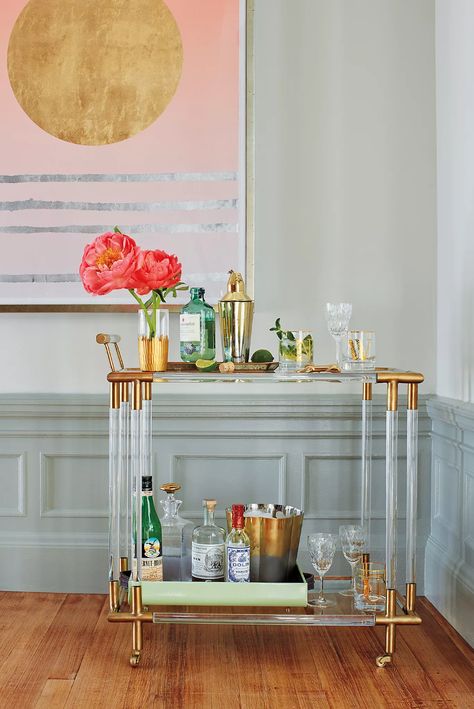Make yourself a cup of coffee, take a moment for you and enjoy our first edition of Homes by JoGio Blog.

BAR CARTS: FAD OR FASHION?
Bar carts have experienced a resurgence in popularity over the past decade, transitioning from a functional piece of furniture to a stylish home decor element. Whether they’re considered a fad or a lasting fashion depends on various factors, including cultural shifts, design trends, and personal preferences.
Fad: Some might argue that the popularity of bar carts could be considered a fad. Fads are typically short-lived trends that gain rapid popularity and then fade away relatively quickly. Bar carts may fall into this category if they are primarily adopted for their aesthetic appeal rather than their functionality. If they become a widely embraced trend for a short period and then start losing popularity as other design trends emerge, they could be seen as a fad.
Fashion: On the other hand, bar carts could be viewed as a fashion that has the potential to endure over time. If the appeal of bar carts extends beyond their visual appeal to their practicality and versatility, they are more likely to become a lasting home design element. If they continue to be integrated into various interior design styles and continue to serve as functional pieces of furniture, they may become a fashion that evolves and adapts with changing design sensibilities.
Ultimately, whether bar carts are a fad or a lasting fashion depends on how well they continue to meet people’s desires for both style and functionality. If they continue to be integrated into different design contexts and continue to serve a useful purpose in homes, they are more likely to be considered a lasting fashion rather than a fleeting fad.
History: The history of bar carts dates back to the early 19th century and has gone through various phases of popularity, functionality, and design evolution. Here’s a brief overview of their history:
19th Century: Serving Carts The precursor to the modern bar cart was the serving cart, which became popular in the early 1800s. These carts were used to transport food, drinks, and tableware from the kitchen to the dining area. They were often made of wood and had wheels for easy mobility. While not exclusively used for alcoholic beverages, serving carts laid the foundation for the concept of movable furniture for entertaining.
Mid-20th Century: Rise of the Cocktail Hour The mid-20th century saw the rise of the cocktail culture, particularly in the United States. This era of social gatherings and cocktail parties led to the popularization of home bars. As a result, bar carts evolved to cater to this trend. These carts were designed specifically for storing and serving alcoholic beverages, glassware, and bar tools. They often featured compartments for bottles, racks for glassware, and shelves for mixers and accessories.
1970s-1990s: Decline in Popularity As design trends shifted away from mid-century modern styles and socializing habits changed, the popularity of bar carts declined. Home entertainment centers and built-in bars became more common, and the need for portable bar storage diminished.
Early 21st Century: Resurgence of Bar Carts In the early 2000s, there was a renewed interest in vintage and retro design elements. As a result, bar carts experienced a resurgence in popularity. Interior designers and homeowners embraced the combination of functionality and aesthetics that bar carts offered. These carts became not only functional pieces but also stylish decor items that added a touch of luxury and sophistication to homes.
Present Day: Versatile Design and Styles Today, bar carts come in a wide range of styles, materials, and sizes to suit various interior design preferences. They have evolved beyond the traditional mid-century designs to incorporate modern, industrial, vintage, and even minimalist aesthetics. Bar carts are now seen not only in living rooms and dining areas but also in bedrooms, offices, and outdoor spaces, showcasing their versatility.
In summary, the history of bar carts traces a trajectory from practical serving carts to iconic pieces of furniture associated with socializing and entertaining. Their resurgence in popularity in recent years speaks to their enduring appeal as both functional and fashionable items for the home. How do you want to create your own bar cart?
Stay tuned for Part 2 of Bar Carts: Creating and styling your Bar Cart
